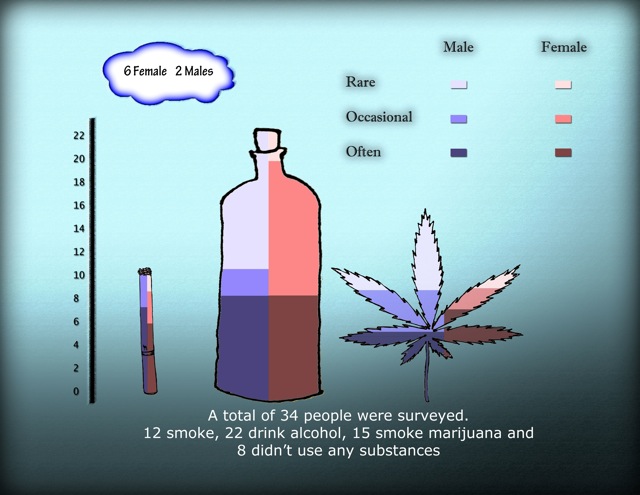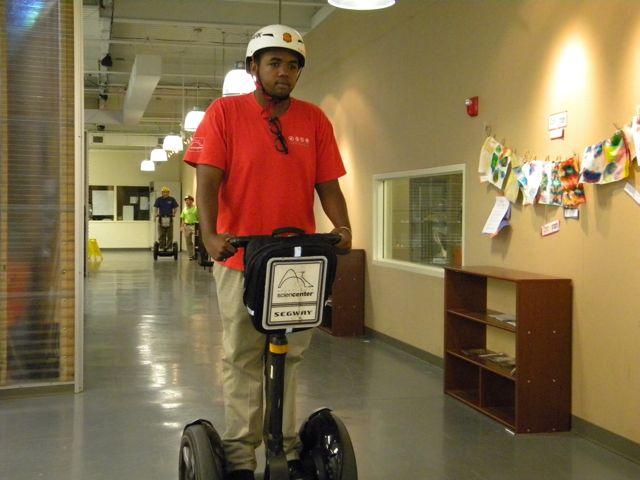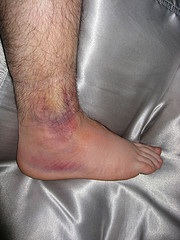X-Prize Challenge from SciJourner on Vimeo.
by Ariel Stavri, SciJourn Reporter


This work is licensed under a Creative Commons Attribution-NonCommercial-NoDerivs 3.0 Unported License
Video Calling of the Future: Here Now from SciJourn Video on Vimeo.

This work is licensed under a Creative Commons Attribution-NonCommercial-NoDerivs 3.0 Unported License

It’s a bike…it’s a scooter… no, it’s a what-cha-ma-call-it.
It’s a Segway! Ever since 2001, Segways have been a more eco-friendly and efficient way to travel over short distances. Creator Dean Kamen, had high hopes for the Segway and so far they have lived up to the hype.
The Segway is a self-balancing personal transportation device with two wheels. Each wheel is run by its own motor and gyroscopes, which are balancing devices, that help keep the device upright and balanced.
Segways can be found at the St. Louis Science Center through a program that provides tours. The average cost of a Segway is around $6000, according to the company.
Photo: Alex Walters


Others aren’t so impressed. Another expert who weighed in on the iPad was originally convinced the iPad is just a larger iPhone. The user interface is too sequential and oversimplified, says Adam Kmiec, Senior Vice President of Interactive Marketing Innovation at MARC USA.
On his blog Kmiec asks, “Is the iPad a killer device? Is it a game-changing device? Will you love it?” Kmiec answers, “The simple answer is YES…so long as you have the mindset of a 3 year old. … Do you like a linear approach for doing things? If so, the iPad is perfect for you. Everything about the iPad interface is linear.”
Despite some negative reviews, the iPad is selling well…maybe, too well. The company has been struggling to meet demand for iPad.
PC World suggests that the U.S. shortage may be a result of Apple stockpiling iPads for its international markets, thereby assuring a steadily supply of tablets across the globe. Some analysts believe the shortage may caused by a shortage of touchscreens used on the iPad, Business Week reports.
Jobs issued a statement in a press release June 22nd, 2010. “We’re working hard to get this magical product into the hands of even more people around the world.”

This work is licensed under a Creative Commons Attribution-NonCommercial-NoDerivs 3.0 Unported License
I woke up in the middle of the night with my head pounding and throbbing. It was like someone was taking their hands and squeezing my head. The pain wouldn’t go away. I sat up all night waiting for the pain to go away, all the while I was getting hotter and hotter but I didn’t have a temperature.  Something was defiantly wrong. Sitting there and trying to deal with the pain brought me to tears. I’ve never felt this way before. What was wrong with my head? My family rushed me to the emergency room. I later found out that what I was experiencing was a migraine.
Something was defiantly wrong. Sitting there and trying to deal with the pain brought me to tears. I’ve never felt this way before. What was wrong with my head? My family rushed me to the emergency room. I later found out that what I was experiencing was a migraine.
Over 30 million people suffer from migraines, according to WebMD. Neurologychannel.com, a medical reference website, states that 75% of migraine sufferers are women.
“Migraines most commonly affect teenage girls; 25% of the populations of migraine sufferers are teenage girls,” says Anne Albers, a nurse practitioner in the Division of Pediatric Neurology at Children’s Hospital at Washington University,
According to the National Institutes of Health and Mayo Clinic, a migraine may be caused by imbalances in brain chemicals called neurotransmitters. This leads to the blood vessel dilating, according to Albers. Doctors have no idea what exactly causes the blood vessels to dilate.
“There’s lots of research going on as to why this happens,” says Albers. “Researchers believe that the calcium channel receptors [which regulate the flow of calcium ions across the membrane in all cells] have something to do with [migranes] and that some blood vessels are more susceptible to these spasms, which would explain why migraines can run in the family.”
“Even though migraines appear to be such a mystery, there are treatment options, which depend on the individual and what that individual’s migraines are like,” adds Albers.
Medications called triptans can stop that spasm right away. Anti-Inflammatory medications, like Ibuprofen and Naproxen, also help. So that the blood vessel isn’t irritated, anti-depressants are usually prescribed.
Which medication is effective also depends on what triggers the migraines. Everyone is different. The easiest way to identify the triggers is to keep a journal, say experts. Doing this you can identify what happens when a headache starts.
“Lots of things can trigger a migraine. For some people its food or chemicals in certain foods, even food coloring can be a trigger. One little girl gets them from blue kool-aid, another little boy from hot dogs. My son gets them from popcorn at the movies if he puts butter on it. Lots of people get them from not eating well, not sleeping well, and not drinking a lot of fluids.” Albers tells SciJourner.
How do you know if your headache is a migraine? “If you start having headaches with other symptoms besides mild sensitivity to light,” says Albers. “Or if you have a family history, for sure go see your doctor. Or if you wake up in the morning with them, and if you’re starting to get them everyday and they wake you up in the middle of the night. That’s when you should be concerned. Go see the doctor and find out whether or not you have migraines.”

This work is licensed under a Creative Commons Attribution-NonCommercial-NoDerivs 3.0 Unported License
We won the World Series and we won the Super Bowl. Our mayor would even say we have the best-tasting tap water in the nation, but he probably won’t tell you we’re number one for Chlamydia.
Chlamydia is the most frequently reported bacterial sexually transmitted disease in the City of St. Louis in 2008, according to the Centers for Disease Control and Prevention.
Chlamydia is a sexually transmitted disease (STD). It is an infection acquired by sexual contact. Chlamydia is the silent STD—you can have it and not necessarily show any symptoms. Early symptoms, if they appear, are abnormal discharge from the vagina or penis and pain on urination. These appear within one to three weeks after infection and are usually quite mild, according to the St. Louis Examiner.
According the Missouri Department of Health and Senior Services, the St. Louis Region reported 5,294 cases of Chlamydia in 2008. Around 70% of those cases involved women infected with chlamydia.
Around 56% of the overall reported chlamydia cases are in the African-American community, the white community accounts for only 10% and 34% are “other” or unknown races.
Although St. Louis is number one in chlamydia, there are also other STDs to be aware of: aids, genital warts, gonorrhea, syphilis, herpes, pubic lice or crabs, and virginities hepatitis.
Those are a lot of different types of diseases that you can come in contact while engaging in anything sexual. Most of these STDs come with symptoms, but some don’t, so you could be living with one and not even know it. It’s always best to go to the doctor if you are engaging in any sexual activity, just to be safe. If you are engaging in sexual activities you can be safe if you use condoms; or you can even practice abstinence.

This work is licensed under a Creative Commons Attribution-NonCommercial-NoDerivs 3.0 Unported License
This kid was in so much pain, from the top of his head to the bottom of his legs. I bet being run over by a truck isn’t as much fun as the stunt professionals makes it out to be, but then I would have to ask the patient how he felt about that question.
It all began with a call to our ambulance. I didn’t really understand what the radio was saying when I was called to the scene of an accident, or so I thought.
When we got to the neighborhood on the north side of St. Louis City I clearly saw that it was an accident, but it wasn’t any regular accident. There was an injured teenager, about 16 or 17 years old, and no car.
Of course the first question that popped into my mind was “Where is the car?”
I was then quickly informed that a truck caused the accident, but was nowhere to be found because the driver ran this kid over and didn’t stop.
What could this kid have been doing to get ran over by another vehicle? Well, he was trying to steal another car in the alley. Not the best idea at night.
There was no bleeding on the outside. But I could see that there were many bruises that were shades of dark purple and red, which indicates internal bleeding. And there was also a collection of cuts .
Because of how painful it was for the kid to have me, the paramedic, and the other EMT to turn him on his back to be placed on the stretcher and into a neck brace, we realized that this kid might need surgery to fix problems that we couldn’t see.
I applied oxygen to the patient, which is a part in the procedure that is used for almost all patients to keep them from going into shock and becoming unresponsive.
I noticed that the patient was closing his eyes slowly and then struggling to keep them open, even after I kept telling him to keep his eyes on me and tried to hold a conversation to make sure that he wouldn’t fall asleep. This would be a sign of some kind of neurological injury, which we wouldn’t be able to help in the ambulance. Instead, the patient would have to get care from the neurological specialist, and until we got to a specialist all we could do was keep the patient alert and active. This task was not easy because I had to take vital signs and make sure that he wasn’t falling asleep.
Taking the patient to the hospital was an experience because I wanted to know more of what happened to him. However, as usual, we took the patient into the emergency room to be admitted and we were back on the road to another call. KiOnty Turner
|
Sidebar: EMT vs Paramedic Have you ever been in the middle of an emergency and someone yelled, “Call the Paramedics!” Why not the EMT? There is a really close relation to the two and yet no one ever calls the EMT. EMTs are emergency medical technicians that assist the paramedic in the transport and care of sick or injured patients. The main focus of an EMT is the operation of the ambulance. According to St. Louis City EMT Monte Chambers, an EMT is responsible for driving and restocking supplies on the ambulance. There is also training and education to become an EMT. It takes close to six months to become certified, in classes offered in a community or trade colleges. EMT classes are also offered in some high schools. Students learn skills such as CPR, and various ways to give oxygen to patients. An EMT assists patients in taking prescribed epinephrine pens, spinal immobilization, and assisting the paramedic with IV setup and EKG monitoring. The role of a paramedic is to take charge of the medical emergency at hand, administer medicines through an IV and monitor EKG readings for each patient as needed. In order to get certified as a paramedic, one has to have be an EMT for at least one year. Paramedics have to learn about drugs and ways to administer them.–KT
|

This work is licensed under a Creative Commons Attribution-NonCommercial-NoDerivs 3.0 Unported License
According to reports, Apple Inc. is turning to the cloud for this year’s innovation in music. Cloud computing is Internet-based computing, whereby shared resources, software, and information are provided to computers and other devices on-demand.

Essentially, iTunes users will have their own “media locker” with Apple. This “locker” will enable users to stream their content from Apple’s servers to their computers. Streaming from your home computers to your other computers, remote devices will be enabled as well. The cloud will additionally bring wireless syncing to iPads, iPhones, and iPod touches; freeing up space on these devices. Such an announcement would be ideal for Apple’s annual iTunes press conference this September
Another company that offers a cloud-centered service is Dropbox. Dropbox is a web-based file hosting service that uses cloud computing to enable users to store and share files and folders with others across the internet using file synchronization. And according to the latest research conducted by NPD Group, a market research company, more than 25% of iTunes users want their media libraries in the cloud.
So a cloud-based iTunes, in theory, sounds great. But like many theories, it has its kinks. Apple has to get necessary licenses from major record labels to stream music from their servers to customers. Even though Apple is already licensed to sale content.
Inside sources told CNET, a news website dedicated to technology, Apple has held discussions about the move to the cloud with executives in the film and music industry.
Ever since Apple acquired the music-streaming company, Lala, they’ve been working on a foundation for their new service. Lala was an online music store that allowed members to legally create online shareable “playlists” of their own uploaded music which could play full length songs for other registered Lala members, purchase MP3s, stream music on a one-time basis or as inexpensively purchased "web songs," buy new CDs from the Lala store, leave blurbs on other members' pages, and participate in the community forums. Lala contracted with major labels and offered a large catalog of albums to stream or purchase. Their home page claimed over eight million licensed songs available.
Apple has not responded to SciJourner's inquiries on this speculative new service.